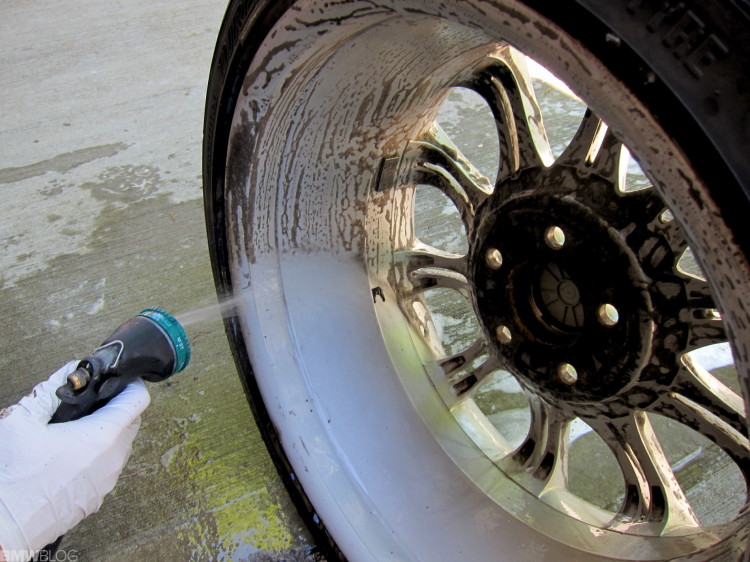Cleaning your wheels and tires regularly is not just an appearance issue- it's preventative maintenance!
If you allow brake dust to sit on your wheels for a prolonged period of time, it can eat into the coating (if there is one) and pit the metal. Brake dust is made of an adhesive and carbon fibers that come off the brake pad and tiny metal shavings from the rotor. The intense heat and friction generated by the wheels makes this mixture highly corrosive. Because you probably drive every day, more brake dust is constantly being made. Frequent cleaning is the only way to keep your wheels safe. A good start is the Pinnacle Concours Wheel and Tire Kit! Check out our Tire & Wheel Care Page for more excellent tire and wheel products.
| Start at the bottom Step 1: When you wash your vehicle, clean the wheels and tires first. This will prevent overspray or grime from splashing onto already-clean panels. If you like to clean your wheels and tires with soap and water, use a separate wash and rinse bucket and soft bristle brush. Step 2: Choose a cleaner that is appropriate for the type of wheels you have. Roughcast aluminum and chrome can withstand stronger cleaners than coated, painted, or anodized wheels. The cleaner will say what it is suited for on the label. For example, Mother's Foaming Wheel & Tire Cleaner can be used on any type of coated wheel, but their Chrome/Wire Wheel Cleaner is not safe for coated wheels. If you are not sure what kind of wheels you have, use a cleaner that is safe for all wheels. I prefer to use a cleaner that works on the tires, too. Wolfgang Tire & Wheel Cleaner is a gel formula that clings to both the tire and the wheel surface to penetrate below the surface. It loosens brake dust that has crept into tiny holes in the metal and into the pores of the rubber. A little agitation with a brush will allow Wolfgang to work even better. If the wheels have brake dust that's caked-on, or if they haven't been cleaned in months or years, consider a more powerful wheel cleaner. Pinnacle Advanced Wheel Cleaner Concentrate is a professional grade wheel cleaner that forgoes caustic acids, butyl ethers, and other harsh detergents that do more harm than good. Pinnacle Advanced Wheel Cleaner Concentrate changes colors as it dissolves brake dust and the concentrated formula can be diluted up to 1:3 with water for maintenance cleaning. Brown tires are all too common, especially when caustic degreasers have been used to clean them in the past, or if they've never been protected with a tire gel. You'd be surprised how many tire and wheel brushes are out there. Basically, you want to look for a brush with feathered bristles for the wheels. This will prevent scratching. The Montana Original Boar's Hair Wheel Brush is a great option. For tires, use Mother's Contoured Tire Brush. Tires require a stiffer brush to really scrub the rubber. Don't be afraid to put a little elbow grease into it, particularly if your tires have layers of old dressings on them. These layers will turn brown and make your tires look worn out if you don't scrub them off. Step 3: Always clean your tires and wheels one set at a time to prevent the cleaner from drying. Wash and then rinse with a strong jet of water before moving to the next tire. Step 4: Don't forget to dry your wheels! Use a Microfiber All Purpose & Wheel Detailing Towel or a terry cloth towel, but not one that you plan to use on any other part of your vehicle. Once a towel is used on the tires or wheels, it should always be used for tires and wheels. Drying prevents water spots and helps you remove every last bit of the brake dust. |
Wax your wheels!Once your wheels are clean and dry, apply a quality wheel protectant like BLACKFIRE SiO2 Wheel Seal or Wheel Wax to seal the wheel surface. These products work just like car wax. Apply them with an applicator pad and then buff the wheel. They keep your wheels looking shiny, and they prevent brake dust adhesion. Your wheels look cleaner longer. You have to reapply these products weekly, but it's better than scrubbing your wheels every two days. The good news is, if you use a wheel wax as recommended, water is the only thing you need to clean your wheels between waxings. Another option is to coat your wheels. Pinnacle Black Label Diamond Wheel Coating blankets your wheels in a rock-hard barrier of protection that is impenetrable by ferrous brake-dust particles, road salt, tar or oil. Designed with brake-dust laden sports cars in mind, Diamond Wheel Coating and the layer of protection it creates makes laborious wheel cleaning a thing of the past. Wheels that are coated with Black Label Diamond Wheel Coating will be easier to clean and maintain. Regular wheel cleaning will only require soap and water, even on brake-dust laden German sports sedans. Diamond Wheel Coating creates such a slick barrier of protection that most dirt and grime will be removed when driving through the rain. A strong jet of water from the hose will also knock off most of the built up brake dust, minimizing the amount of scrubbing required. Directions:
|
Dress for SuccessChoose your tire dressing carefully. Old formulas contain silicone, which produces a glossy shine but it turns brown over time. These dressings deplete the rubber's own protectants faster, causing it to age prematurely. Newer formulas, like Pinnacle Black Onyx Tire Gel or Optimum Opti-Bond Tire Gel, are water-based and less shiny. They create the look of new tires with a semi-gloss sheen that doesn't turn brown. Pinnacle Black Onyx Tire Gel also nourishes the rubber to recreate the look of new tires. You can often layer water-based dressings to get a glossier shine. Follow the directions on the label carefully. Always apply thin coats and allow drying time before you drive your vehicle. Even the best dressing will sling off if it's on too thick or it doesn't have time to dry. Another option is to use a tire coating, like Pinnacle Black Label Tire Clear Coat or Tuf Shine Tire Clear Coat. These two products are semi-permanent, with an edge going to Pinnacle Black Label Tire Clear Coat for overall ease of use. Pinnacle Black Label Tire Clear Coat is an acrylic-based resin that forms a flexible, chemical-resistant coating on your tires. Engineered to outlast and outperform conventional oil and water-based tire dressings, Pinnacle Black Label Tire Clear Coat will not wash or sling off and will not turn tires brown. A single application of Pinnacle Black Label Tire Clear Coat will provide several months of protection, even in extreme climates. Pinnacle Black Label Tire Clear Coat dries to the touch it even passes the white glove" test! Pinnacle Black Label Tire Clear Coat also does wonders for whitewalls and raised white lettering! If you have a classic car or a lifted four wheel drive pickup truck, Pinnacle Black Label Tire Clear Coat will keep your whitewalls or raised white lettering bright and white for several months. Dressings provide UV protection and prevent drying, cracking and fading. With a little TLC, your vehicle's wheels and tires will look as sharp as the rest of your ride! See our Metal Polishing Guide for details on wheel polishing.
|
Car wheels are among the filthiest car components. They collect dust, dirt, grease, and grime—you name it. Aside from accumulating into nasty buildups, they can interfere with your car’s performance and make rides less enjoyable.
Therefore, it is very important that you pay enough attention and invest time and effort into taking care of them. To do that, you should know how to clean car wheels and rims.
Even though you may be tempted to just simply blast a stream of high-pressure water to wash them, this is not enough. There are other steps that you must take to clean rims and tires properly.
In general, the steps to clean car rims at home are:
You can learn the details and other essential information on cleaning wheels as you read. So, what are you waiting for? Go on! Below, you will find the best way to clean car wheels and rims.
Table of Contents
You have to gather the following materials:
Among the materials listed above, you have to be a bit more selective with the wheel cleaner and wheel cleaning brush.
First, for wheel cleaners, it is incredibly important that you spend time researching before you make your final purchasing decision. There are many wheel cleaners available in the market. So, it is not a problem to find them. But you must consider various factors to find the right one for you: formula, ease of application, brand, and price.
Generally, the best wheel cleaner features a safe formula that is eco-friendly and biodegradable. It is usually stocked in an ergonomically designed spray bottle for easy application. Plus, it is made by well-known brands that have been in the niche auto industry for a long time, and most wheel cleaners like this have a price range from $8 to $20.
Apart from that, your cleaner of choice should come with straightforward, clear instructions on how to use and apply. If the directions are wishy-washy, choose a different cleaner.
To give you a head start, take a look at these top-tier options: Adam’s Wheel Cleaner, Meguiar’s G180132 Ultimate All Wheel Cleaner, and CAR GUYS Wheel Cleaner.
Second, for wheel cleaning brushes, it is necessary that you find one specifically made for working with tires. Once you begin your brush shopping endeavor, you may be surprised by how many types are available in the market. Make sure you have researched adequately before picking one up at a local store or an e-commerce site.
A good quality wheel cleaning brush should have soft but stiff bristles that are safe for delicate surfaces: matte, painted, polished, chrome, etc. In addition, there should be a long handle for easy gripping and maneuvering. Typically, you can get a decent wheel cleaning brush for $30 to $40.
Here are a few reliable options that you can consider if you are unsure of where to start: Mothers Wheel Brush and Tire Cleaner, VIKING Microfiber Metal Free Rim and Wheel Brush, and Chemical Guys ACC602 Extended Reach Wheel Brush.
What You Will Need to DoStep 1: Turn off your car and check if the tires are ready to be cleanedFirst, you need to switch off your car and check that the tires are cool to touch.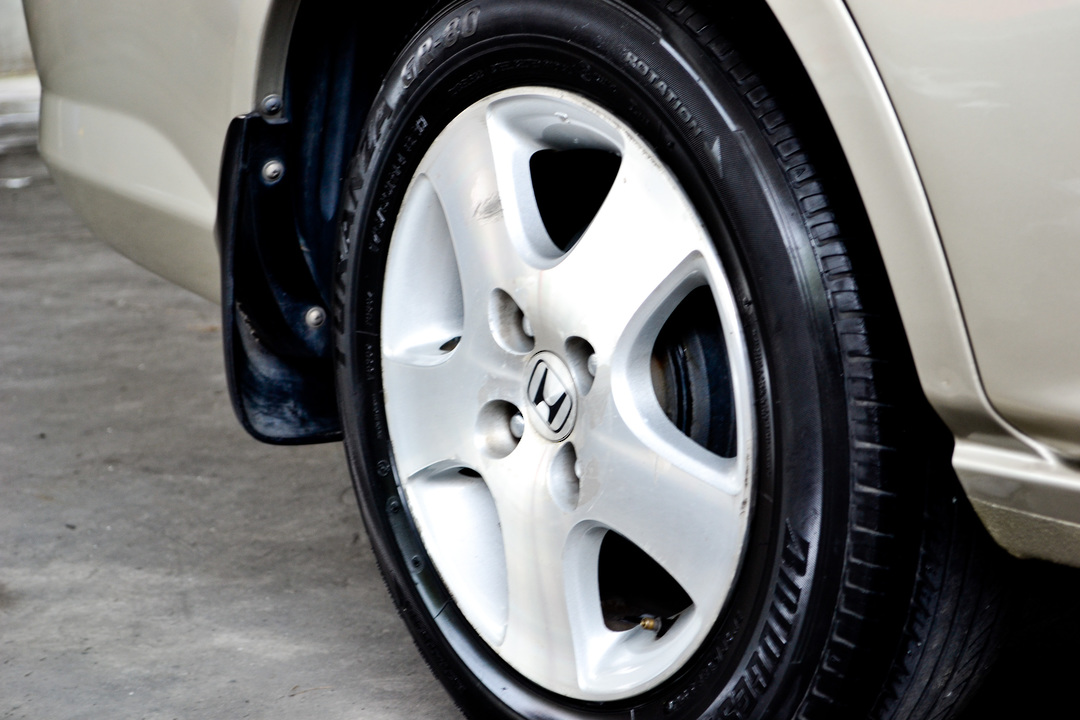 If not, wait until it is no longer hot or warm before moving onto the next step.
If not, wait until it is no longer hot or warm before moving onto the next step.
Second, grab your garden hose and use it to spray the wheels caked with filth. Make sure that the water stream coming out of the hose is high pressure. Otherwise, it will not be enough to force out the gunks. Spray thoroughly to get rid of as much loose filth as possible. The more you can remove at this point, the easier it will be for you later.
Step 3: Apply the wheel cleaner as guided in the descriptionsThird, apply the wheel cleaner that you have prepared. Make sure that you use it as guided. Each product will have specific instructions on proper use. Some cleaners will have to sit for a few minutes while others will be ready for scrubbing right away. Do not deviate from the directions on your cleaner’s descriptions or packaging.
Step 4: Scrub the wheel and rims with a brush in circular motionsFourth, scrub.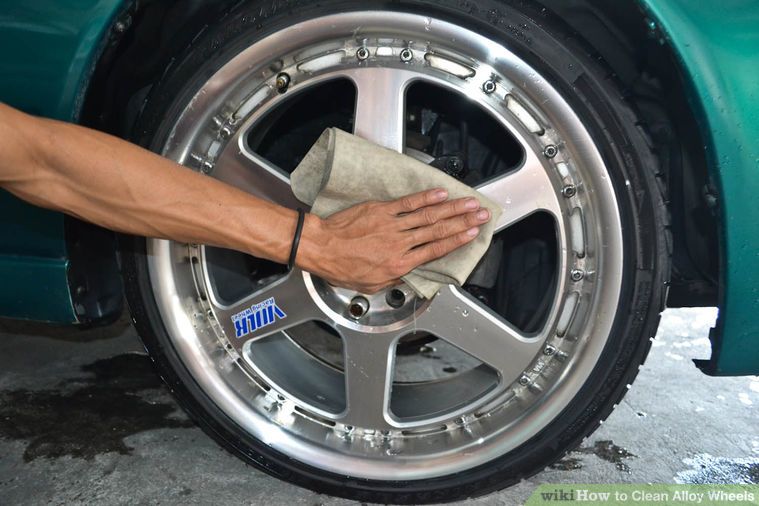 Use a wheel cleaning brush and circular motions. Do this carefully, as well as not forget to reach all the nooks and crannies.
Use a wheel cleaning brush and circular motions. Do this carefully, as well as not forget to reach all the nooks and crannies.
Fifth, wash the cleaning solution away. Use the same high-pressure hose from the first step. Check that there are no residues. Most cleaners contain chemicals that should not stay on your wheels and rims for too long. Therefore, be meticulous and make sure that the tires are hosed down completely.
Step 6: Scrub the wheels and rims thoroughly with a DIY solutionSixth, give your wheels and rims another wash with a DIY solution. In a bucket, mix water and car washing soap. Then, soak a microfiber towel in the solution and use it to scrub. Again, do this with circular motions. Start from the outer edge of the rims and work your way inwards. Take the time to scrub thoroughly, especially the crevices.
When you notice that the towel is collecting dust, dirt, grease, or grime, rinse it and re-soak it in the solution to continue scrubbing. Repeat this step as many times as needed until you are sure that the tires are free of filth.
Repeat this step as many times as needed until you are sure that the tires are free of filth.
Top Tip: You can use a toothbrush to scrub the hard-to-reach areas.
Step 7: Rinse the wheels and wash off all the soapSeventh, rinse the just-scrubbed wheels and rims using the high-pressure hose. Clear out all the soapy lather on the outside and inside of the tires. Only proceed to the next step when you are guaranteed that they are clean.
Residues can cause etching and potentially damage the materials of your tires. Remember, better safe than sorry! Triple check to make sure.
Step 8: Dry all the wheels and rims completelyEighth, let it drip dry for two to three minutes. Then, use a fresh, dry microfiber towel to pat it dry. You may have to use several towels to finish this step for all four tires. It is slightly time-consuming but surely rest assured that the outcome is rewarding.
Step 9: Coat a protective layer to prevent future filthNinth, apply a protective coating on your wheels and rims to complete. This prevents filth from clinging onto your tires. Thus, it will ensure that your next cleaning session is more time-saving and less tedious.
This prevents filth from clinging onto your tires. Thus, it will ensure that your next cleaning session is more time-saving and less tedious.
So, there you have it! Congratulations on reading through all the steps in the best way to clean car rims and wheels. Now, you can apply what you have read. It was not as difficult as you thought, right?
ConclusionAs you have read, there is more to cleaning car tires than blasting them with high-pressure water. There are materials that you need to prepare and steps that must be carried out with care. Reading about how to clean car wheels and rims is the first step. Next, you have to put what you have read into practice.
Just remember, there are nine steps to take, starting from turning off your car and checking if they are ready for cleaning, to drying them off and coating a protective layer to prevent future filth.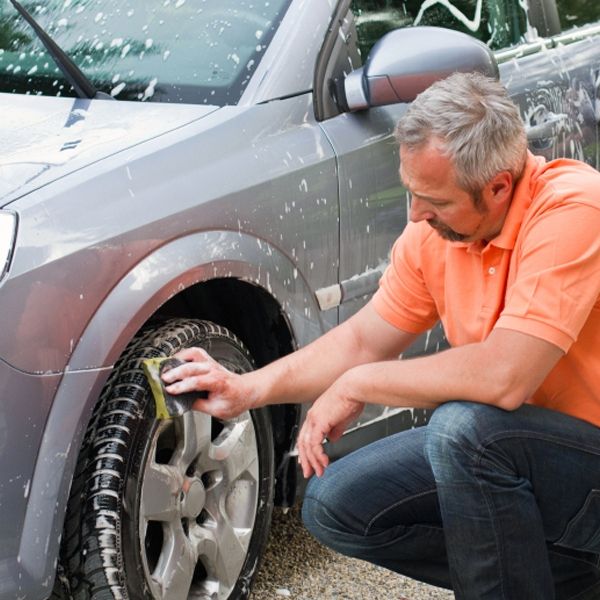
But feel free to bookmark this article so you can refer back to it whenever you need to.
After you have tried this yourself, share the experience with us in the comments. If you have questions or thoughts, you are welcome to leave a comment as well.
Do not forget to share this article’s content with your friends, family, or any car owners you know will appreciate the content!
Category: Operation and maintenance Technical information
Article reading time: 3 minutes
Save to bookmarks
The right technology and the right detergents will help get rid of brake dust and gravel stuck in the tread, improving the safety of the car, driver and passengers.
How to wash tires we will tell in this article.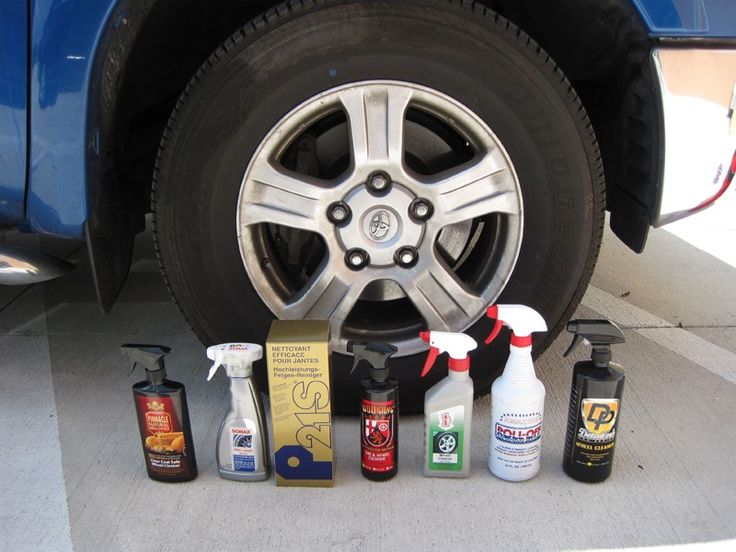
To clean the wheels from dirt, dust and oil residues, you will have to act according to the following plan:
 Traces of solvent or oil will stain the cleaned rubber.
Traces of solvent or oil will stain the cleaned rubber. In the final, the wheel is applied with a protector that protects the tires from the harmful effects of ultraviolet radiation.
To clean dried-on dirt from rims and wheels, you will need a machine that generates high-pressure water. Such installations are produced by American and European companies, so they are quite expensive, but they can be replaced with an ordinary hose and a special nozzle that accelerates the water jet to a pressure sufficient to clean the car.
To remove residual dirt, you will need a medium-hard bristle brush and a cleaning solution that is used to treat wheels and rims. This solution can be prepared from household chemicals found in the kitchen or bathroom, or bought at an automotive store. Moreover, store products are divided into universal foam cleaners and solutions based on weak acids, which can only process car rims. By the way, if you don’t know how to wipe rubber off a car, try this solution.
By the way, if you don’t know how to wipe rubber off a car, try this solution.
To wash the wheels of cleaning products, you need the same high-pressure apparatus or a hose with a nozzle. But as a napkin that will wipe off the remaining water, you need to use only clean microfiber from the package.
Winter Drive protection
Tires Goodyear UltraGrip Arctic 2 SUV
Winter Drive Protection Sound Comfort
Rating:
4.5
Tires Goodyear UltraGrip Ice 2
Winter Drive protection
Tires Goodyear UltraGrip Performance+ SUV
Winter Drive protection
Tires Goodyear UltraGrip Arctic 2
Winter Drive Protection Run On Flat Sound Comfort
Tires Goodyear UltraGrip Performance+
To prepare a solution that can clean dirt from tires, dilute in a small amount of water to half a standard bottle of dishwashing detergent.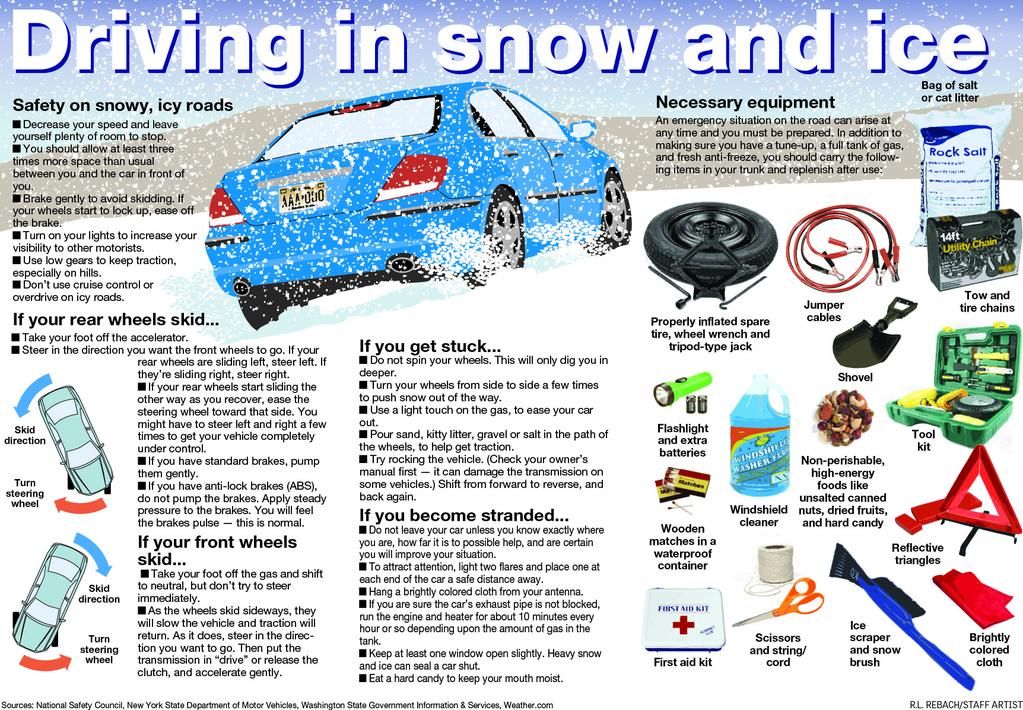 Pour the resulting concentrate into a container into which it is convenient to dip a car brush. Thanks to the abundance of surfactants found in dish detergent, a homemade solution will clean tires as well as a factory cleaner.
Pour the resulting concentrate into a container into which it is convenient to dip a car brush. Thanks to the abundance of surfactants found in dish detergent, a homemade solution will clean tires as well as a factory cleaner.
Rules for the use of home remedies that can clean wheels are similar to the recommendations of manufacturers of commercial drugs. Before treating tires and rims with home remedies, make sure you wash the tires. Otherwise, brake dust and gravel residues will turn into abrasive particles that can scratch the tread when you scrub it off dirt with a brush or sponge. Do not try to clean the wheel with an old cloth that has been used to clean the engine compartment or bodywork - it will stain the wheel with oil or gasoline.
Article author: The Goodyear team
Popular related articles
Tire regrooving
(
Updated:
05/12/2022
)
Which tires are better: narrow or wide?
(
Updated:
05/12/2022
)
How are tires tested?
(
Updated:
05/12/2022
)
How and why to blacken rubber?
(
Updated:
05/12/2022
)
Does the braking distance depend on the tires?
(
Updated:
05/12/2022
)
Proper break-in of studded tires
(
Updated:
05/12/2022
)
 Inexpensive! — magazine Behind the wheel
Inexpensive! — magazine Behind the wheel LADA
UAZ
Kia
Hyundai
Renault
Toyota
Volkswagen
Skoda
Nissan
GAZ
BMW
Mercedes-Benz
Mitsbishi
Mazda
Ford
We are pronounced. everything can be recommended for use.
Related materials
5 cool and inexpensive Chinese car ideas for autumn
You don't have to go to a car wash or a spare parts store to get your tires back to a deep black color. You can get by with improvised means, and some of them are sure to be found in almost every home.
There are several ways to blacken tires that are safe and do not affect traction. In the absence of special means for restoring color, for example, shoe polish, glycerin, silicone oil, and even laundry soap and household chemicals are used. Each substance has its pros and cons, but it should be remembered that none of them fully possesses the qualities inherent in special solutions: neither long-term effect, nor protective properties, nor ease of use.
Related materials
11 factors that the driver needs to remember in the fall
Blackening tires with shoe polish or other shoe care product is the first thing that comes to mind. At the same time, the processing process itself is no different, only instead of a brush it is better to use a sponge so that splashes of shoe polish do not stain the body. We simply rub the sidewall of the washed and dried tire with shoe polish and let it dry.
To be honest, the result does not look very good, even when using the product with wax: there is neither shine nor color depth. The application process itself is also inconvenient - imagine what it would be like to process four wheels. The downside is that you have to wait for the shoe polish to dry completely before driving. Otherwise, road dust will quickly stick to the treated surface, reducing all the efforts made to nothing. Of course, there are also quick-drying paint creams, but their cost is such that it will still be cheaper to buy a special product for blackening tires.
Due to its consistency, glycerin creates a stunning jet-black shiny tire effect, and the degree of "greatness" can be adjusted by diluting the product with plain water. For one procedure, only one hundred grams of glycerin and the same amount of water are enough. We mix them, taking into account the fact that the less water in the composition, the more "fat" the effect will be. But it’s better not to spare water, otherwise dust will stick to the tires, as in the case of wet shoe polish. The composition is applied with a simple sponge without rubbing. By the way, unpainted black plastic body parts can also be processed with this composition.
The advantage of this method is its low cost and the availability of glycerin in any pharmacy. The cons cover all the advantages: glycerin quickly ages rubber, causing it to crack. In addition, the composition is very well washed off with water - the very first rain or driving through a puddle will not leave a trace of glycerin.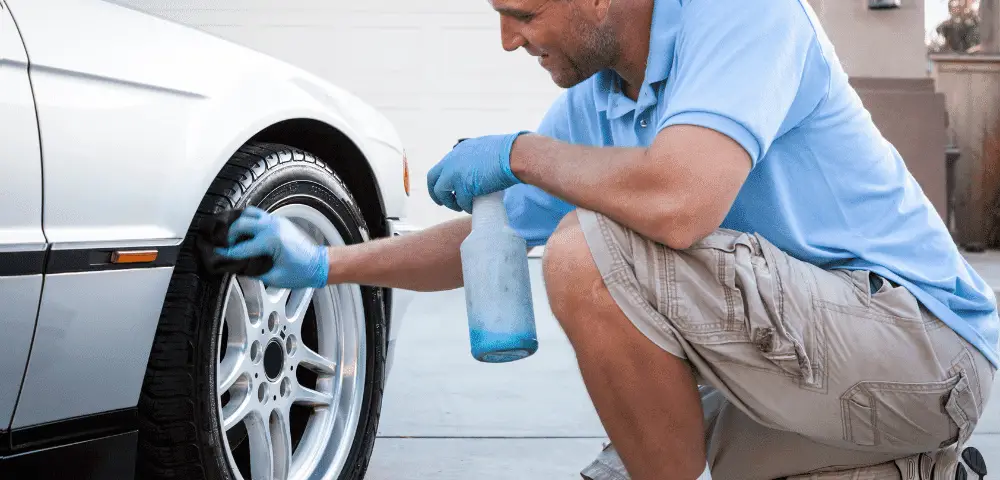 In dry weather, tires will only stay black for a couple of days.
In dry weather, tires will only stay black for a couple of days.
Related materials
How to sit behind the wheel - check your fit
Blackening tires with silicone oil is not the cheapest way because it is not sold in small containers and you will have to buy an annual supply of funds right away. This method is the simplest, most efficient and less labor-intensive than the others. It is better to use medium viscosity oil, which will also come in handy for treating tires before winter or summer storage - this is the only substance described that somehow protects rubber from cracking, drying out, ultraviolet radiation and moisture.
The effect after treatment with silicone oil is long-lasting and the tires look blacker than new. Silicone oil is also treated with door seals and trunk lids so that they do not freeze.
Laundry soap is probably the cheapest product available for blackening tires. It can be applied with a pre-soaped brush, or by dissolving a crumb of soap in water, apply the composition with a sponge. There is no need to rinse off the soap: when it dries, the rubber will acquire a beautiful and deep black tint. Like most artisanal methods, blackening tires with laundry soap has its drawbacks. Rubber because of it, as in the case of glycerin, ages faster and may begin to crack, so we do not recommend this method of blackening.
It can be applied with a pre-soaped brush, or by dissolving a crumb of soap in water, apply the composition with a sponge. There is no need to rinse off the soap: when it dries, the rubber will acquire a beautiful and deep black tint. Like most artisanal methods, blackening tires with laundry soap has its drawbacks. Rubber because of it, as in the case of glycerin, ages faster and may begin to crack, so we do not recommend this method of blackening.
Related materials
Preparing the car for winter: what needs to be done first
Household chemicals are often used in car washes. This is a cheap, effective and harmless method for rubber and its adhesion to an expensive method, which can be offered as a bonus or "gift". It is mainly used for washing glasses, as well as dishes. The first is sprayed onto the sidewall of the tire and rubbed quickly, while the second is applied with a damp sponge. It is not necessary to wash off the compositions.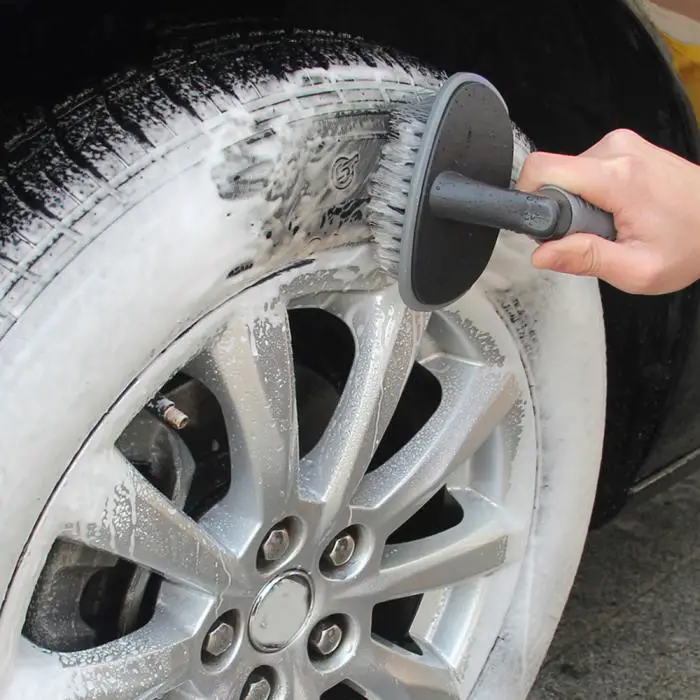
Also on the forums it is advised to blacken tires with drinks. More often than others, Coca-Cola is mentioned. But because of the sugar in the composition of the cola, it creates a sticky layer, on which dust quickly settles, and is easily washed off in the first puddle.
***
All of the listed products, of course, are inferior to the special compounds sold in auto chemical departments. Their blackening effect is short-lived and does not look so beautiful. In addition, most of them can harm rubber by affecting its chemical composition and reducing its service life. Nevertheless, the described methods are in demand due to their availability and spontaneity, because most motorists do not need to blacken tires every day.
However, the safest alternatives to professional tire blackeners are silicone and household chemicals. The latter is usually also cheaper.
Photo: depositphotos.